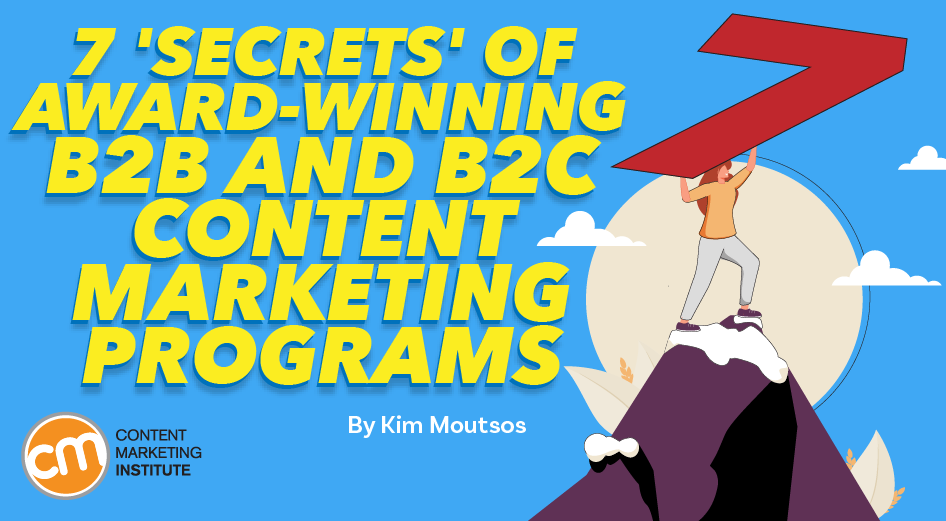Ever look at an organization’s content and think, “How do they do it?”
Same here. So we asked a group of admired content leaders – 2021 Content Marketer of the Year finalists – for a peek behind the curtain of what makes their award-winning projects work. (Each nominee this year worked on a winning entry in at least one category in the Content Marketing Awards.)
You’ve likely heard variations of their advice before (hence the quotation marks around “secrets” in the headline). But their input reinforces that the fundamentals of content marketing work.
Here’s what they told us about why their content programs resonate with audiences and keep the support of business leaders who invest in them. Stay tuned for more in-depth looks at their award-winning projects over the coming weeks.
1. Build (internal and external) teams that mirror your audience
 Jackie Gagne, senior vice president, multicultural marketing, HBO Max and HBO, says:
Jackie Gagne, senior vice president, multicultural marketing, HBO Max and HBO, says:
Our team reflects the audiences we speak with daily, and our partners also reflect the audience. Both are very passionate about multicultural audiences and creating moments that give back to underrepresented groups.
Our focus is on Black, AAPI, LGBTQ+, and Latinx audiences. In each vertical, we have audience experts, and that was very intentional. We are the experts when it comes to these audiences.
If there’s a multicultural marketing or emerging markets team in the organization, I encourage you to work closely with them to develop your strategy. If that expertise doesn’t exist within the organization, then absolutely find an agency partner who knows and has experience with the audiences you want to engage.
In Black, AAPI, LGBTQ+, and Latinx verticals, we intentionally have audience experts, says @jackiegagne10 of @HBOMax and @HBO via @CMIContent. #CMWorld Click To Tweet2. But don’t assume you know the audience, even when you are the audience
 Julie Shapiro, editor-in-chief, The Well by Northwell, Northwell Health, says:
Julie Shapiro, editor-in-chief, The Well by Northwell, Northwell Health, says:
The key to The Well’s success is our data-driven approach to content creation. We know what our readers are interested in because we study them. We learn about their needs and curiosities at the different stages of life and formulate concepts for content around those findings. And we don’t do it in a stuffy, formal way.
When we started, we were “intuition-driven,” meaning the team (made up of all women/chief medical officers of the household) would get together and brainstorm about the things that mattered to us. We assumed we knew what people wanted because we were the target audience.
Now that we are data-driven and spend a good amount of resources studying trends to really know what our demo is searching for, I’d say we weren’t wrong, but we didn’t understand how much more people were interested in – topics we hadn’t even thought of. So my advice is to get to know your audience and give the people what they want.
Data-driven research tells you even better than intuition-driven what your audience really wants, says #JulieShapiro of @NorthwellHealth via @CMIContent. #CMWorld Click To Tweet3. Keep listening and adapting
 Claire McIntosh, editor-in-chief, Sisters From AARP; senior editor, AARP The Magazine and AARP Bulletin, AARP, says:
Claire McIntosh, editor-in-chief, Sisters From AARP; senior editor, AARP The Magazine and AARP Bulletin, AARP, says:
I’ll meet a writer for lunch or virtual coffee. She’ll tell me how she handled things with the school principal when her daughter was being bullied, and I’ll ask her to write about it. Early on, I shared with senior vice president and editorial director of AARP Media, Myrna Blyth, that I saw my role as that of a “listener-in-chief.” Reader feedback always shapes what we offer. One example is a recently added advice column by a therapist they know from reality TV.
#B2C Content Marketer of the Year @ClaireRMcIntosh sees her role at @AARP as the listener-in-chief via @CMIContent. #CMWorld Click To Tweet4. Promote your content inside to connect outside
 Carl Germann, senior marketing manager – brand communications, Monster, says:
Carl Germann, senior marketing manager – brand communications, Monster, says:
We use Bambu by Sprout Social to share content internally so that it gets shared externally. It’s been a wonderful tool for us. We had great success in leveraging that for our sales team during the early months of the pandemic, which allowed them to keep in contact with their clients and stay relevant.
We just kept sharing content and data points through this platform internally, and they could then put it right onto their own LinkedIn. They can put it on Twitter. Now we do it two to three times a week, and it’s a constant flow.
At @Monster, we use @BambuBySprout so employees can easily share our #content on Twitter or LinkedIn, says @crlgrmnn via @CMIContent. #CMWorld Click To Tweet5. Understand what matters to your business
 Richard McGill Murphy, editor-in-chief and director, ServiceNow, says:
Richard McGill Murphy, editor-in-chief and director, ServiceNow, says:
One of the main things we care about as a content marketing organization is seeing how many Workflow readers engage with the ServiceNow brand in a way that increases the chance that they will become customers. Things like what percentage of Workflow readers click off to get assets on ServiceNow.com either directly or indirectly. Do they read an article and then go to ServiceNow and read the about-us page or give up an email address (a marker of trust)?
That’s something we track super closely. I think the exciting opportunity in content (at least the editorial thought leadership side) is to show how you’re contributing not just to brand awareness but ultimately to the business funnel. We’re not product marketers. But it’s important to be able to show that we’re sending people from an editorial experience to the top of the marketing funnel, where they can be captured as leads.
It’s exciting to show how #content contributes not just to brand awareness but ultimately to the business funnel, says @RichardMMurphy1 of @servicenow via @CMIContent. #CMWorld Click To Tweet6. Get a seat at the table
 Jessica Bergmann, vice president, content and customer marketing, Salesforce, says:
Jessica Bergmann, vice president, content and customer marketing, Salesforce, says:
We’ve worked hard to make content marketing a strategic function and an integral part of marketing. If you look at integrated planning teams, sometimes the content marketing team is seen as the blog and social. We’ve made the transition where each team has an embedded content strategy lead.
Now we talk about “the four Cs” at the brand level: content, creative, campaigns, and Customer 360 (our product marketing team). No plans happen without those four Cs being aligned and involved.
2021 B2B Content Marketer of the Year @jbergmann of @salesforce says no project happens at brand level without #content, creative, campaigns, and product marketing via @CMIContent. #CMWorld Click To Tweet7. Get executives on board
 Julia Gaynor, senior marketing strategist – B2B, Monster, says:
Julia Gaynor, senior marketing strategist – B2B, Monster, says:
It’s important to have some type of champion at the executive level who will enable you to have the tools you need to get these things done. That’s it. We couldn’t have done it without my boss at the time.
Have a champion at the executive level who will enable you to get things done, says @juliagaynor of @Monster via @CMIContent. #CMWorld Click To TweetNo one goes it alone
In talking with these world-class marketers, one theme surfaced again and again. Content marketing isn’t a solo sport. All great content programs rely on collaboration – within teams, across teams, and even with the audience.
As 2021 B2C Content Marketer of the Year Claire McIntosh says: “When you collaborate with innovators from across the enterprise, you access a breadth and caliber of talent that wouldn’t be available with a dedicated team. You can punch above your weight class.”
What tips do you have for making your content program punch above its weight class? Feel free to share in the comments.
Tools mentioned in the article were cited by the sources. If you have a tool to suggest, please add in the comments.
Cover image by Joseph Kalinowski/Content Marketing Institute

